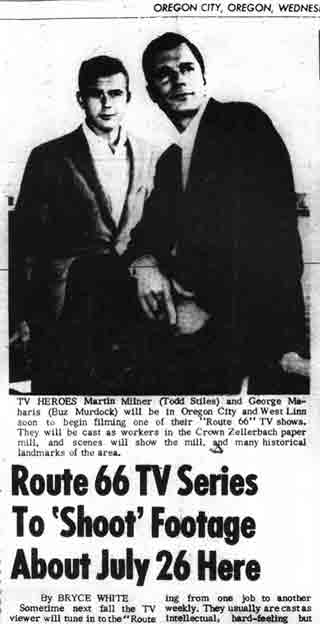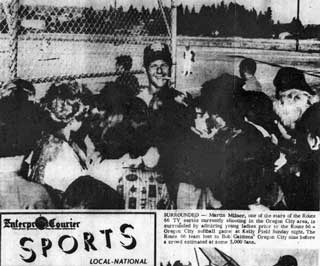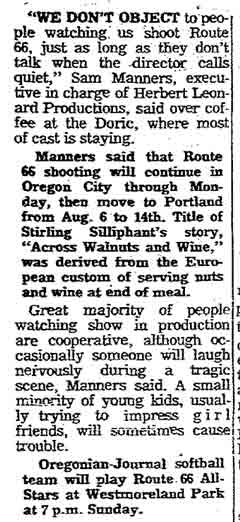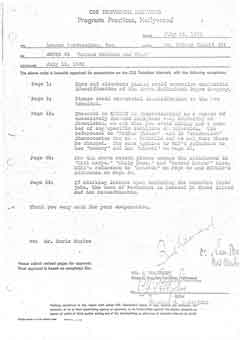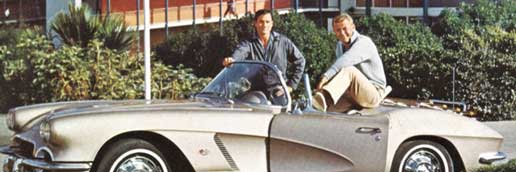FADE IN:
EXT. DREYFUS GRAIN ELEVATOR TOWERS & DOCK (PORTLAND, ORE.) - DAY
MOVING SHOT
A ship is loading at the dock. We are in close at the stern, reading
the name of the ship and the place of origin: the ship is foreign - Indian,
perhaps; or Japanese. WE PAN, opening up a wider perspective as we watch the
activity on the dock. WE PAN, TILTING UP, TO CATCH THE ELEVATOR TOWERS FROM
A LOW ANGLE. (PLEASE PICK UP A WILD TRACK OF THE ACTUAL SOUND BACKGROUND AND
SCORE IT IN HERE) OVER THIS MOVING SHOT, MOVING WITH THE CAMERA'S MOVEMENT, WE SUPERIMPOSE THE LEGEND: PORTLAND,
OREGON [city, state is penciled in — ed.], Saturday, July 14, 1962. We leave the legend
long enough to establish, then take it out.
HIGH ANGLE - FROM TOP OP GRAIN ELEVATOR - TOD looking down to a catwalk about halfway up one section of the elevators. TOD
is working there. There are other workmen engaged on the same job. CAMERA
PANS.
FULL SHOT - PERSPECTIVE TO MATCH ANGLE FROM HEIGHT A OF CATWALK ON WHICH TOD IS WORKING - BUZ BESIDE THE FUNNEL WHICH
DROPS GRAIN ONTO THE CONVEYOR BELT. Buz watches, hand signalling [sic] the man
on the tower at the winch to keep the grain coming.
CLOSE SHOT - GRAIN DROPPING ONTO CONVEYOR BELT
It drops and the belt turns and carries it away to disappear under the protective glavanized [sic] metal roof.
BUZ AND WORKMAN - ANGLE TO HOLD CATWALK
The noise level is high as the grain continues to drop. A workman
comes out along the catwalk and climbs up to stand beside Buz. He taps Buz on
the shoulder and when Buz turns toward him, he shows Buz the wristwatch which he wears so that the face of the watch is on the inside
of his wrist. He taps the watch face with a finger to draw Buz'
attention to it. Buz looks and reacts to the fact that he is late for sure. He
slaps the workman's shoulder by way of thanks, moves out of the Frame as he starts back along the catwalk. The
workman grins. The noise level is too high for us to hear, but we see his lips
form the words as he shouts after Buz.
WORKMAN
Have a good time!
ANGLE TO HOLD BUZ
As he moves back along the catwalk beside the conveyor, moving toward the dock on the run.
TOD AND OTHERS ON CATWALK - MEDIUM GROUP
Tod's back is to the dock. One of the other
workmen is faced so that he can look down and see Buz, Offscreen at this angle. He
taps Tod and signals Tod to look down toward Buz. Tod turns and looks down.
BUZ - HIGH - TOD'S POV
Buz is running along the dock, signalling [sic] Tod to get going with a wild motion of his arm. Buz
is moving toward the building in which the men change clothes. Now, moving toward
Buz is a group of workingmen, and as they come toward him, Buz, still on the dead run, begins to strip, handing his hard hat to the
first man to come up to him, then beginning to unbutton his shirt. The entire
group moves in a clump toward the building in which the men change.
TOD - MEDIUM CLOSE
He reacts. He begins to move, himself.
LOW ANGLE - TO FEATURE TOD
as he comes down the ladder which gives access to the dock, coming down toward us until his bulk blacks out the entire
Frame.
INT. LOCKER ROOM AND ENTRANCE TO SHOWER ROOM - DAY
MOVING SHOT
Which follows along the trail of Buz' clothing, moving through a cluster of men gathered around
the lockers and doing something there, although what they are doing we cannot see for their bodies interpose. Camera
is carrying us toward the shower room entrance. Buz comes out, wet and wrapped
with a towel around his middle, grinning; as Tod, grinning, dry, a towel wrapped around his middle, comes into the shot from the
edge of the Frame, moving into the shower room.
BUZ
We gonna make it?
TOD
It's close! Close!
Buz, moving out toward us, blanks out the entire screen.
MOVING SHOT
We are in very close on a Workingman at one of the lockers. CAMERA
IS PULLING BACK. Workingman turns, a shirt held ready in his hand for someone
to get into it. CAMERA PULLS BACK QUICKLY, WIDE ENOUGH TO INCLUDE BUZ, NOW. Buz
slips into the the [sic] shirt as more workingmen move into the shot to begin buttoning it. The
workingmen move between Buz and us, their broad backs blanking out the entire screen.
FULL SHOT - TO FEATURE TOD
sitting on a bench in formal pants, buttoning his shirt, as two workingmen try to get his shoes on his feet. He
stands, still buttoning the shirt, stepping hard on the shoe at the same time, trying to get it on. CAMERA
PANS TO BUZ, buttoning his Tux jacket as someone finishes tying the bow tie for him. TOD
MOVES INTO THE FRAME, someone putting on his jacket and now we see that both boys are dressed in formal attire. The
other workingmen step back as Buz and Tod strike a vaudeville stance for an instant.
BUZ
Introducing -- Murdock and Stiles --
TOD
Songs, jokes, and wily patter!
BUZ
Quick change artists extra-ordinaire!
Someone stuffs a handkerchief into his jacket pocket.
TOD
Gentlemen, we thank you one and all.
We'll see you Monday morning --
Tod glances at his watch. Buz glances at his watch. Still
in vaudeville style, Tod makes a flourishing gesture for Buz to go first. Equally
polite and flourishing, Buz gestures Tod to go first.
TOD
After you, Mr. Murdock.
BUZ
After you, Mr. Stiles.
They lock arms and start out in a vaudeville time step. The other
workingmen laugh. Tod and Buz are gone, out of the room and the other workingmen
begin to pick up their work clothes and stuff it into their lockers.
BUZ VOICE (OS)
Hey --!
All heads turn toward Buz' Voice.
ANOTHER ANGLE - TO FEATURE BUZ AND TOD
As they come back into the locker room on the dead run.
BUZ
The flowers!
TOD
What'd we do with the flowers?
There is a scramble of action. Someone runs to one of the lockers,
and someone else to another locker. Now, from out of these lockers come what
look like two lunch pails. CAMERA MOVES IN AS THE GROUP MOVES IN. We
see the lunch pails opened. Dry ice is removed from the top layer. Now,
from out of the pails comes a carnation for Buz and one for Tod, immediately thrust into the buttonholes of the jackets; and from
the other pail come two corsages - one of each of these is thrust at Buz and one at Tod.
BUZ
(To one and all) -
What would we ever do without you ?
Again, Buz and Tod move out.
...

